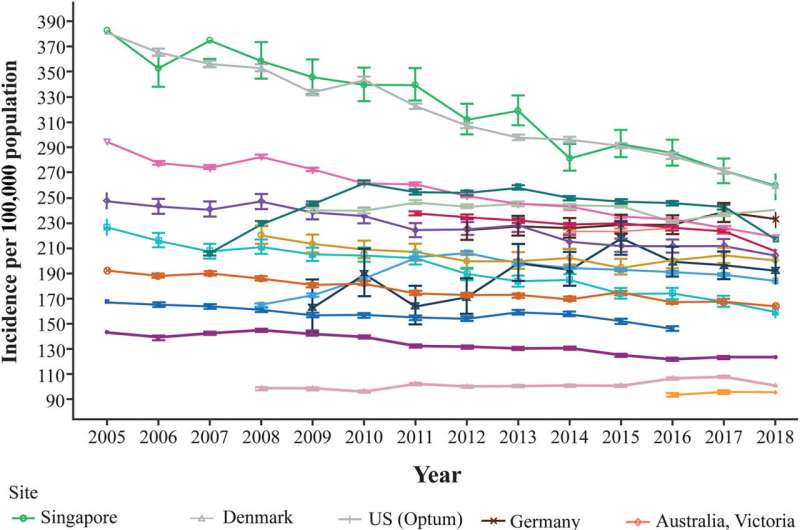This article has been reviewed according to Science X's editorial process and policies. Editors have highlighted the following attributes while ensuring the content's credibility:
fact-checked
peer-reviewed publication
trusted source
proofread
Call for prevention action as study predicts global hip fractures to almost double by 2050

Of all osteoporosis-related fractures, hip fractures cause the most morbidity, with reported mortality rates up to 20-24% in the first year after a hip fracture. Loss of function and independence among survivors is profound, with 40% unable to walk independently, and 60% requiring assistance a year later. Hip fractures represent a major global public health concern, which places a heavy burden on patients, and their families, and represents a significant cost burden to health care systems.
In a study recently published in Journal of Bone and Mineral Research, an international group of researchers evaluated the secular trends in hip fracture incidence, post-fracture treatment, and all-cause mortality in 19 countries across five regions from 2005 to 2018.
The study reveals that while the age- and sex-standardized hip fracture incidence rates decreased in most regions, the number of hip fractures worldwide are projected to nearly double by 2050 compared to 2018. A significant post-fracture treatment gap in fracture prevention was also observed for both sexes in all countries and regions, particularly in men. Males also had higher rates of all-cause mortality and a larger increase in the projected number of hip fractures by 2050.
Professor Cyrus Cooper, President of the International Osteoporosis Foundation (IOF) and a co-author of the global study, stated, "The findings of this important study highlight the urgent need for improved strategies in hip fracture prevention and care. This should be seen as both a warning and a call to action for health care systems worldwide. Past studies have shown that five to 10% of hip fracture patients go on to experience a recurrent hip fracture, and of these, as many as 23% occur in the year following their first hip fracture, and 70% within the first five years.
"Clearly, the enormous osteoporosis treatment gap, which the study found to be even higher in men than in women, is unacceptable. Health care systems must act. A first step is to prioritize the implementation of post-fracture care coordination programs, such as Fracture Liaison Services, to ensure that any older adult who has sustained a first hip fracture receives the needed treatment and management to prevent further, potentially life-threatening fractures."
The international study analyzed data from a large representative cohort involving 19 countries in Oceania, Asia, Europe, North- and South America. It examined the incidence of hip fractures, post-fracture treatment, and all-cause mortality following hip fractures, among patients aged 50 years and older, from 2005 to 2018.
The study is unique: In contrast to previous reports on hip fracture incidence that are based on data with heterogeneity in data sources, study periods, and analytical approaches, it applied a standardized protocol and a common data model across all sites to provide comparable data.
Age- and sex-standardized incidence rates of hip fracture were estimated using the 2020 United Nations world population as a standard. The number of hip fractures in 2030, 2040, and 2050 were projected based on the trends in the incidence rates and the World Bank data. Within 12 months following hip fractures, post-fracture treatment (defined as the proportion of patients receiving anti-osteoporosis medication), and the all-cause mortality rates were estimated.
The study identified 4,115,046 hip fracture cases in the cohort, with the following key findings:
- The reported age- and sex-standardized incidence rates of hip fractures ranged widely, from 95.1 (Brazil) to 315.9 (Denmark) per 100,000 population.
- Most countries and regions showed a decreasing trend in hip fracture incidence, with the most pronounced declines in Denmark (‐2.8% per year), Singapore (‐2.8%), and Hong Kong (‐2.4%). The largest increases were noted in the Netherlands (+2.1%), and South Korea (+1.2%).
- Despite the overall decline in hip fracture incidence, the total number of hip fractures is estimated to nearly double from 2018 to 2050.
- Within 1 year following a hip fracture, post-fracture treatment remained low, ranging from 11.5% in Germany to 50.3% in United Kingdom.
- One-year all-cause mortality rates following hip ranged from 14.4% (Singapore) to 28.3% (United Kingdom), while mortality trends varied from ‐5.3% to +18.4% per year.
- Males had lower use of anti-osteoporosis medication than females, higher rates of all-cause mortality, and a larger increase in the projected number of hip fractures by 2050.
Professor Nicholas Harvey, Chair of the IOF Committee of Scientific Advisors, concluded, "One of the study's key takeaways is that the decrease in age-and sex-specific hip fracture incidence observed in numerous countries over the past few years will not compensate for the global impact of aging populations. The burden of hip fracture will thus continue to grow, leading to increased dependency, morbidity, and mortality, and resulting in immense socio-economic costs for resource-strapped health care services worldwide.
"The time for action is now. IOF urges health care care systems to address the treatment gap through targeted policy and multidisciplinary intervention to reduce the impact of the hip fracture in the coming decades."
More information: Chor‐Wing Sing et al, Global Epidemiology of Hip Fractures: Secular Trends in Incidence Rate, Post‐Fracture Treatment, and All‐Cause Mortality, Journal of Bone and Mineral Research (2023). DOI: 10.1002/jbmr.4821





















